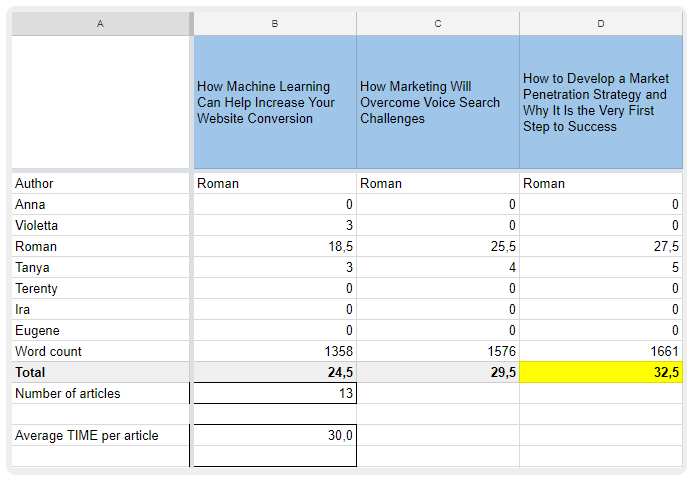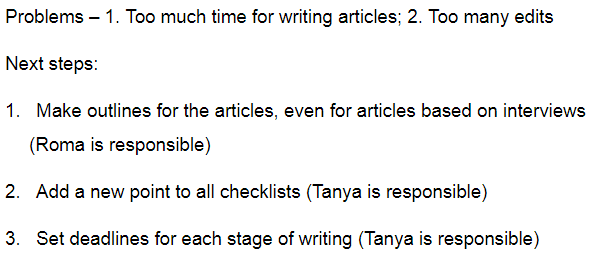A precisely built planning process is like magic. As our company has improved our planning process over the course of many months, we have accumulated some valuable experience on this topic and want to share it with you.
In one of our articles, we already discussed the importance of daily planning and methods of building a working daily planning process.
In this article, we’ll explain how to properly conduct monthly briefings that can help you get many leads and make your content creation process function like a well-oiled machine.
Monthly Briefings Help Save Time and Money
There are two main consequences of implementing monthly briefings.
- You’ll find out what activities writers spend too much time on.
We already pointed out in one of our articles that we discovered we had a problem with our company writers spending too much time on editorial corrections.
We were able to solve this problem only because our editor noticed it while preparing for the monthly briefing. During that briefing, we outlined steps to solve this issue. We shortened the time spent by writers on edits and gave them more time to write articles. In this way we were able to generate more content and get more leads.
How Can Kraftblick Help Your Software Company?

- We build marketing strategies from scratch and fix existing ones. More about that here.
- We provide consultations to company owners, directors, heads of marketing and sales, marketers. This is how we do it.
See you soon 🙂
- You will be able to quickly solve problems across the entire content department.
During monthly briefings, content specialists will be able to talk about their problems and offer action steps to solve them. For example, a writer may say that he or she spends too much time posting articles on the blog, and management may respond by buying special software to facilitate the process.
How to Conduct Monthly Briefings So They Give Positive Results
Now let’s discuss how to conduct monthly briefings step by step.
- Instruct the editor or other members of your content team to prepare for the briefing.
Ideally, you should entrust conducting briefings to your editor.
“Good editors have the unique ability to view writers and their products from the outside, which authors themselves rarely can,”
says Geoffrey Keating, the Senior Editor at Intercom.
If you do not have one, you can do all the work yourself, or entrust it to specialists in your content department.
First, the editor must compile a list of current problems. To do this, he or she needs to see how much time was spent on certain activities and collect the numbers in a separate file. For example, our editor uses two files for these purposes.
The first file is called “time tracking.”

In this file, our editor sees how much time writers spent on their activities.
We have a list of activities for which we log our working time, which you can see in the picture above: “outline”, “writing”, “corrections”, “publishing”, “planning”, etc.
At the end of the workday, members of our content team log time for the activities that they were engaged in during the day.
Previously, we used the time logging function in Trello, a rather simple project management tool. Now we use Active Collab, one of Trello’s alternatives. In the near future, we plan to release an article where we will explain in more detail why we changed our project management tool.
After the team logs their time, our editor puts all the numbers in the time tracking file, which she later uses to prepare for the briefing.
The second file is called “content tracking.”

In this file, our editor tracks how we are keeping up with the monthly plan and how much time is spent on each article.
You can instruct your editor or content specialists to collect all the necessary data into similar files. Based on the numbers, the editor should get a good understanding of what activities content specialists spent too much time on.
The editor should record his or her observations in the form of problems, such as: “the writers spend too much time on planning” or “the designer does not have time to illustrate all the articles.”
After that, the editor or some other specialist must draw up a plan for the briefing. He or she should list the problems and in what order they will be discussed, and allocate time for the briefing. In our company, the briefing is one hour long, making them quick and efficient.

If time is limited, each specialist tries to speak as succinctly as possible. This ensures that your briefings do not turn into lengthy philosophical discussions. (Image source: rulit.me)
- Instruct the editor or other members of your content team to conduct the briefing.
To begin, the editor or another responsible person should state the problems, simply naming them in the order in which they are recorded. If anyone else has other problems to discuss, they should be added to the list. Then the editor gives everyone a chance to speak and lists suggested solutions to the problems.

It is important that everyone speaks in turn. (Image source: youtube.com)
Everyone who can offer a solution must voice the idea. If it is a good suggestion, it will be considered a generally accepted way to solve that particular problem.
The editor or another responsible person then writes down the appropriate solutions and specifies action steps for each specialist to overcome the problems. For example, if the problem is related to writing articles, it is logical to assume that it should be solved by the writer. In this way, each specialist becomes responsible for the implementation of his or her action steps.

The results of our briefings look something like this.
At the end of the briefing, the specialist reports how he or she solved various problems.
- Instruct the editor or other members of your content team to repeat the whole cycle every month.
It is very important to implement a process that ensures that the briefings are held every month, not just held once and then forgotten. To do this, the responsible person (editor, etc.) should prepare for the monthly briefings and remind all members of your department of the briefings in advance.
Between briefings, a responsible person should monitor the progress of all action steps that specialists must take to ensure that they are completed. Our editor creates tasks with deadlines and content team members report to the editor on their progress every Friday.
In each briefing, the content team should discuss the results of the previous briefing and how they were implemented. The editor should review the problems that were raised at the last briefing, and then discuss resolution with the person who was appointed responsible for each.
Wrap-up
Monthly briefings will help your content team produce more content, thereby improving the entire content department’s ROI. A monthly briefing will help you learn about all the problems in your department and appoint specialists to solve them promptly.
To hold productive monthly planning briefings:
- Choose a responsible content specialist and instruct him or her to prepare a briefing.
- The leader should hold a briefing in accordance with all of the recommendations provided in the article.
- Ensure that your content specialists repeat the briefing every month.
What does the planning process in your company look like? Do you hold monthly briefings?